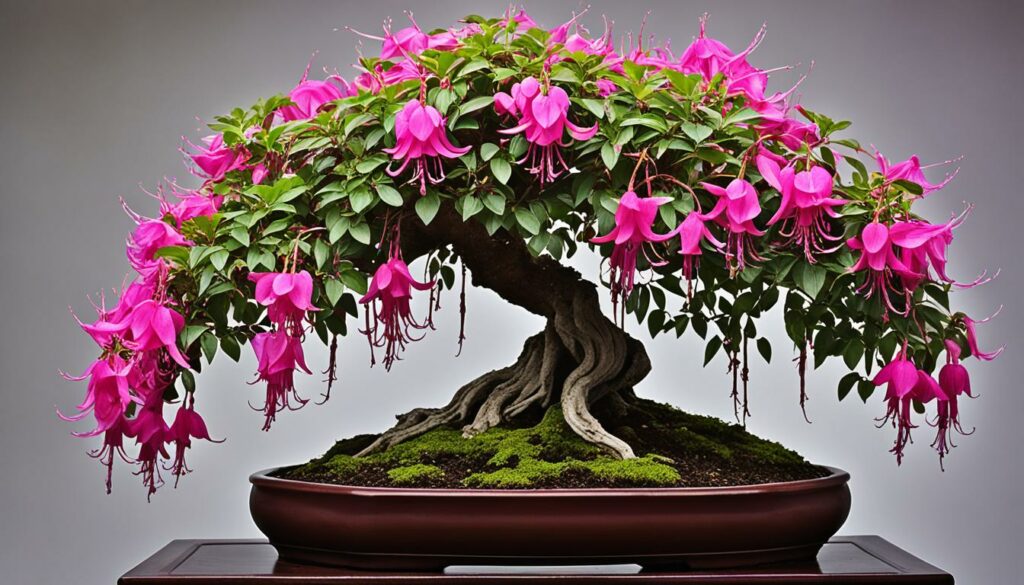If you’re looking for a stunning and unique addition to your bonsai collection, look no further than the Bonsai Tree Species Fuchsia. With its vibrant flowers and distinctive trunk shape, the Fuchsia bonsai is sure to capture your heart and imagination.
Key Takeaways
- The Bonsai Tree Species Fuchsia is a captivating addition to any bonsai collection.
- The Fuchsia bonsai is known for its stunning flowers and particular trunk shape.
- Proper care, including pruning, shaping, and repotting, can ensure the health and longevity of your Fuchsia bonsai.
- There are various styling options to choose from, such as informal upright, cascade, and broom styles.
- Following a seasonal care guide can help maintain the beauty of your Fuchsia bonsai throughout the year.
What is a Bonsai Tree Species Fuchsia?
A Bonsai Tree Species Fuchsia is a specific variety of the popular Fuchsia plant that has been pruned and trained to resemble a miniature tree. This deciduous bonsai is known for its vibrant flowers, small leaves, and distinctive trunk shape. Fuchsia bonsai trees are a delightful addition to any bonsai collection, as they offer a splash of color with their beautiful blossoming.
The Fuchsia bonsai is a popular choice for those who appreciate the art of bonsai. This particular species is native to South America and is known for its striking colors and delicate blooms. It is also a relatively easy tree to care for, making it an ideal choice for beginners and seasoned bonsai enthusiasts alike.
The Unique Characteristics of Fuchsia Bonsai Trees
Fuchsia bonsai trees are known for their unique characteristics. They have a distinct trunk shape, which is often twisted or gnarled, and small, glossy green leaves that complement their vibrant flowers. The flowers themselves are a sight to behold, with their exotic, pendulous blooms branching out from the tree’s slender branches.
Fuchsia bonsai trees are deciduous, meaning they lose their leaves during the winter months. However, they are quick to produce new growth in the spring, with colorful blooms appearing throughout the warmer months. This makes Fuchsia bonsai trees a great choice for those who enjoy the changing seasons and the unique beauty they bring.
The History of Fuchsia Bonsai Trees
The history of Fuchsia bonsai trees can be traced back to their origins in South America. Fuchsia plants were first introduced to Europe in the 17th century, and it wasn’t long before they became a popular ornamental plant. The art of bonsai also emerged around this time, with many enthusiasts keen to create miniature versions of trees and plants using pruning and training techniques.
It wasn’t until much later that Fuchsia bonsai trees became popular in their own right. However, once they did, they quickly became a favorite among bonsai enthusiasts worldwide. Today, Fuchsia bonsai trees can be found in many different styles and sizes, with each tree reflecting the unique personality and style of its owner.
The Beauty of Flowering Bonsai
Flowering bonsai trees, such as the Bonsai Tree Species Fuchsia, offer a unique and captivating display of nature’s beauty. The Fuchsia bonsai’s colorful blossoms add a touch of vibrancy and elegance to any bonsai collection.
When it comes to flowering bonsai, the Bonsai Tree Species Fuchsia is one of the most impressive. Its bright and bold flowers are sure to catch the eye, while the delicate leaves and unique trunk shape create a stunning visual contrast.
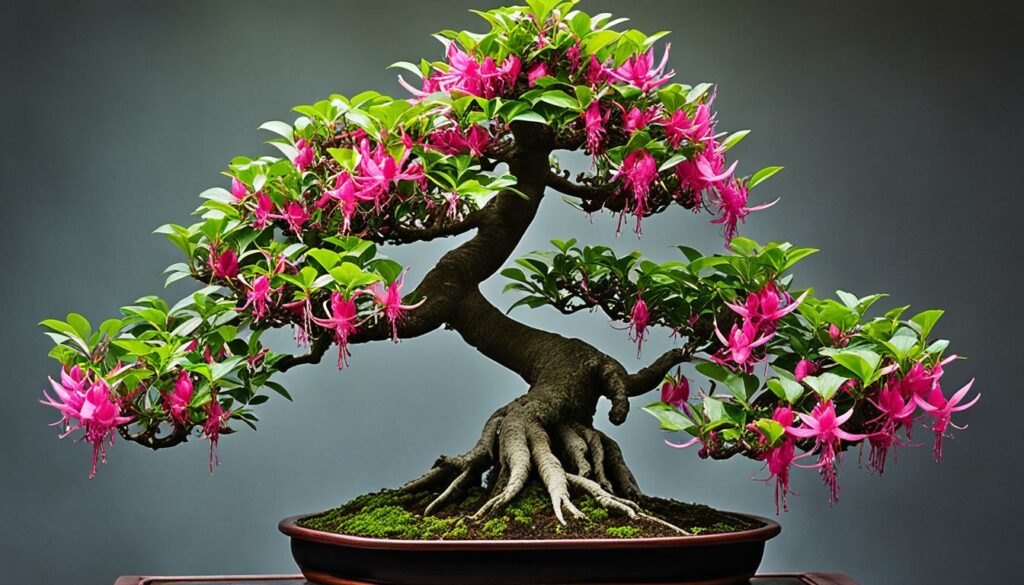
The Fuchsia bonsai is truly a work of art, showcasing the beauty and complexity of nature in a miniature form. Whether placed on a windowsill, or displayed as the centerpiece of a room, this bonsai species is sure to make a statement.
Being able to witness the blooming of a Fuchsia bonsai is a truly magical experience. The vibrant colors and intricate details of the flower petals are a testament to the beauty of nature, and a reminder that even the smallest things can hold immense power and awe-inspiring wonder.
Growing and Care Tips for Fuchsia Bonsai
Proper care is crucial for the health and longevity of your Fuchsia bonsai tree. Follow these tips to ensure your tree thrives:
Watering
Water your Fuchsia bonsai regularly, never allowing the soil to dry out completely, nor let it be too wet. Ensure that the pot has proper drainage holes. Water the tree slowly and deeply, ensuring full saturation. Use rainwater or filtered water to avoid mineral buildup that can damage your tree’s roots.
Lighting
Provide your Fuchsia bonsai tree with adequate sunlight, but avoid direct exposure to harsh rays. Place your tree in a bright, well-lit room and rotate it regularly to promote even growth. Consider using grow lights in environments with insufficient natural light.
Pruning
Prune your Fuchsia bonsai tree regularly to promote healthier growth and desired shape. Using sharp, clean scissors or pruning shears, remove dead, diseased, or damaged branches and leaves. Pinch back new growth to encourage fuller foliage and smaller leaves. Avoid over-pruning, which can stunt growth and damage your tree.
Fertilizing
Fertilize your Fuchsia bonsai tree regularly during the growing season to provide essential nutrients. Apply a balanced, soluble fertilizer half the recommended strength every two weeks. Fertilize less frequently during the winter dormancy period.
Temperature and Humidity
Maintain proper temperature and humidity levels to facilitate the optimal growth of your Fuchsia bonsai tree. Ideal temperatures range from 60-75°F (15-24°C) with adequate ventilation. Humidity levels must range from 50%-70% to avoid dry air that can damage your tree’s foliage and prevent pests from inhabiting your plant. Use a humidity tray or a room humidifier to sustain suitable conditions.
Choosing the Right Pot and Soil
Choosing the right pot and soil for your Fuchsia bonsai is crucial to ensure its optimal growth and health.
The ideal pot for your Fuchsia bonsai should provide adequate drainage and offer sufficient root space for growth. A pot with a diameter of 8-10 inches is suitable for an average-sized bonsai tree. Bonsai tree pots come in various materials, such as plastic, ceramic, or clay. Ceramic and clay pots are preferred for their natural aesthetic and durability, while plastic pots are lighter and easier to move.
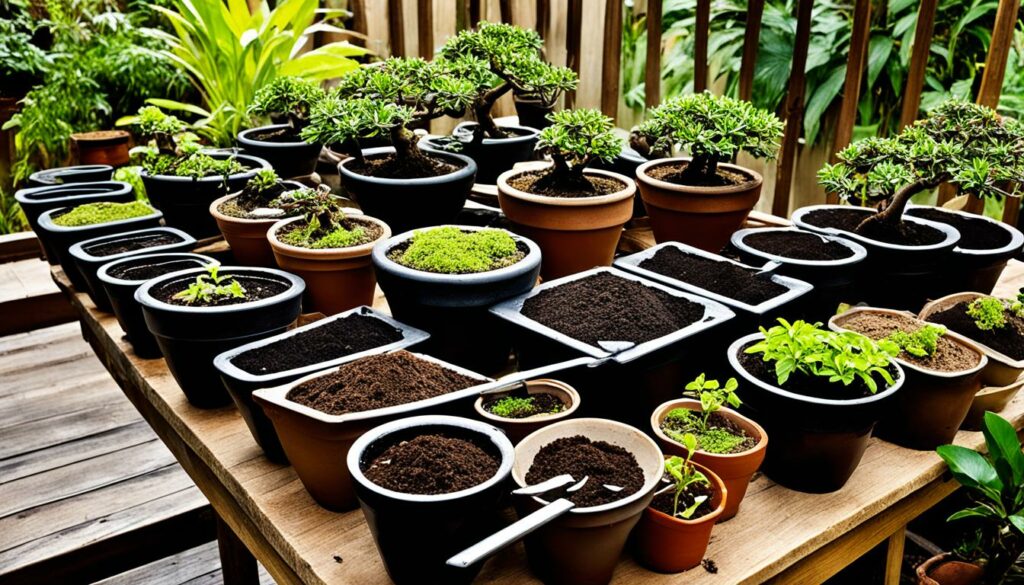
Choosing the right soil is equally important to ensure the overall health and vitality of your Fuchsia bonsai. Bonsai soil should offer good drainage, moisture retention, and sufficient nutrients. A well-draining soil mix consisting of organic matter, such as pine bark, coarse sand, and peat moss, is recommended for the Fuchsia bonsai.
Remember to repot your Fuchsia bonsai every two to three years to refresh the soil and ensure proper root development.
Pruning and Shaping Techniques
Proper pruning and shaping of your Fuchsia bonsai are crucial in maintaining its desired form and aesthetics. These techniques also help enhance its natural beauty. Here are some essential tips on how to prune and shape your bonsai tree.
Pruning Fuchsia Bonsai
Pruning involves removing unwanted leaves, branches, and roots to improve the bonsai’s overall health and appearance. For Fuchsia bonsai, the best time to prune is during early spring when the new growth starts to emerge.
Use sharp and clean pruning tools to avoid damaging the tree. Cut off any dead, weak, or diseased branches and leaves, making sure to leave a slight angle to allow water to drain off.
If you want your Fuchsia bonsai to have a fuller appearance, pinch the tip of each stem as it grows to encourage branching out.
Shaping Fuchsia Bonsai
Shaping involves training the bonsai tree to grow in a specific style or form, adding to its artistic appeal. Fuchsia bonsai can be styled in various designs, such as the informal upright, broom, or cascade styles.
Begin shaping your Fuchsia bonsai early on by wiring the branches into your desired shape. Use high-quality bonsai wires and wrap them around the branches firmly but not too tight, as the branch may get damaged.
Keep an eye on the wire to prevent it from digging into the bark. Remove the wire after six to eight weeks to avoid it from leaving marks on the bark.
TIP: Always observe the branch’s natural growth pattern when deciding on the shape and direction to train it to, and never force it into unnatural positions.
Repotting and Transplanting Fuchsia Bonsai
Fuchsia bonsai require periodic repotting, typically every two to three years, to ensure their roots have space to grow and receive proper nutrients. Transplanting, on the other hand, involves moving your bonsai to a new pot with fresh soil.
The best time to repot your Fuchsia bonsai is in early spring, just before new growth appears. Before repotting, inspect the roots carefully and prune any that are unhealthy or too long. This will encourage the development of new roots and prevent your bonsai from becoming root-bound.
When choosing a new pot for transplanting, consider the size of your bonsai. It should be slightly larger than the current pot, allowing for future growth. Use well-draining bonsai soil, with a mixture of Akadama, pumice, and lava rock.
To repot your Fuchsia bonsai, gently remove it from the current pot and shake off the old soil. Trim the roots to fit the new pot and place your tree in its new home. Add fresh soil around the roots and water generously. Protect your bonsai from direct sunlight for a few weeks after repotting to avoid transplant shock.
Note: Repotting every year accelerates the growth of your bonsai, resulting in a compact, well-branched tree.
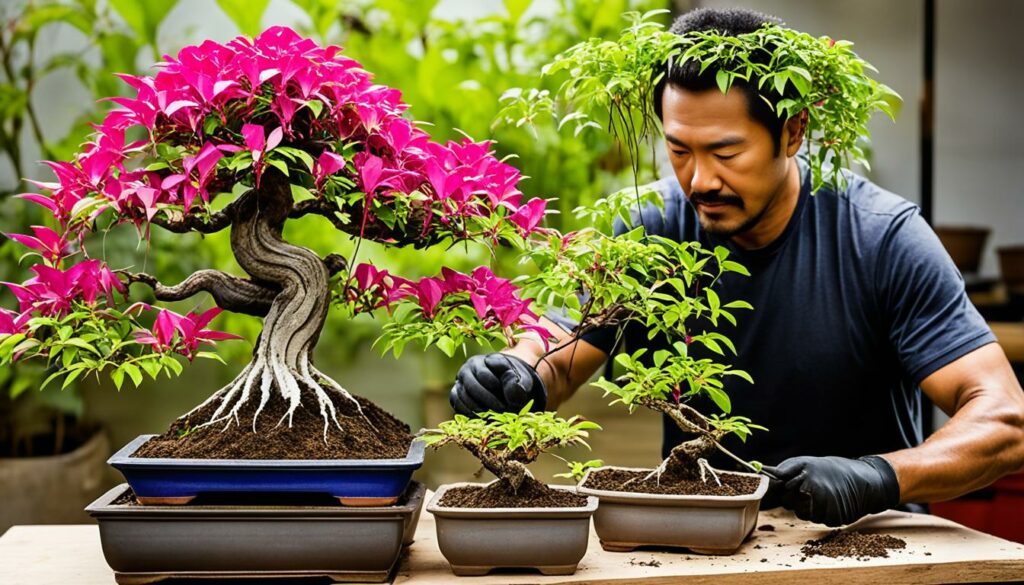
Transplanting is similar to repotting, except you are moving your bonsai to a new pot. It’s best to transplant your Fuchsia bonsai every three to four years, or when its roots fill the current pot.
To transplant your Fuchsia bonsai, carefully remove it from the current pot and gently separate the roots. Trim any damaged or excessive roots, and add soil to the new pot. Place your bonsai in its new home, fill the pot with soil and water well.
Repotting vs. Transplanting
| Repotting | Transplanting |
|---|---|
| Replacing soil in a current pot | Moving a bonsai to a new pot |
| Recommended every two to three years | Recommended every three to four years |
| Prevents root-bound and promotes new growth | Prevents root-bound and provides fresh soil and nutrients |
No matter which method you choose, repotting or transplanting is crucial for the health and growth of your Fuchsia bonsai. Follow these tips and enjoy the beauty of your bonsai for years to come.
Protecting Fuchsia Bonsai from Pests and Diseases
Pests and diseases can pose a significant threat to your Fuchsia bonsai’s health; knowing how to prevent and treat them can help maintain its vibrant blooms and foliage. Keep your bonsai healthy and thriving with these tips:
Common Bonsai Tree Pests
Some common pests that can infest your Fuchsia bonsai include spider mites, scale insects, aphids, and whiteflies. These pests typically consume your bonsai’s leaves, stem, and flowers, leading to visible damage. Early detection of pests is crucial to prevent widespread infestations and prevent irreversible damage to your bonsai.
Tip: Check your bonsai regularly for signs of pest infestations, like holes and mottled leaves, webbing, or sticky residue on the branches.
Preventing Pest Infestations
The best way to prevent pest infestations is to maintain a clean and healthy environment for your bonsai tree. Avoid placing it near other infested plants or in crowded, humid areas. Additionally, ensure your bonsai is appropriately watered, fertilized, and receives sufficient sunlight to boost its immunity and help defend against pests.
Treating Pest Infestations
If your Fuchsia bonsai experiences any pest infestations, act quickly to prevent further damage. You can treat minor pest infestations by washing your tree with water or spraying it with an insecticidal soap, but ensure the soap is suitable for bonsai trees and apply it according to the manufacturer’s instructions. For severe pest infestations, it may be necessary to use a pesticide. Always read and follow the instructions carefully, and avoid using any chemical sprays when your Fuchsia bonsai is flowering.
Bonsai Tree Diseases
Fuchsia bonsai trees are susceptible to several diseases, including root rot, powdery mildew, and leaf spot. These diseases can cause your bonsai’s leaves to drop, discoloration, and overall poor health. Preventing and treating diseases is crucial to keep your bonsai healthy and thriving.
Preventing Bonsai Tree Diseases
One of the most critical steps in preventing bonsai tree diseases is proper care. Ensure your Fuchsia bonsai receives adequate sunlight, water, and nutrients to promote healthy growth and a strong immune system. Avoid overcrowding your trees and ensure they are correctly spaced to promote air flow and prevent humidity buildup.
Treating Bonsai Tree Diseases
If your Fuchsia bonsai tree has contracted a disease, the sooner you act, the better the chances of recovery. Some common treatments include removing the affected leaves or branches, repotting the bonsai into fresh sterile soil, or using an appropriate fungicide. Always consult a professional bonsai expert to ensure proper diagnosis and treatment of any disease.
By taking preventative measures and treating any pest or disease issues promptly, you can ensure your Fuchsia bonsai remains vibrant and healthy for years to come.
Fuchsia Bonsai Styling Options
The Fuchsia bonsai offers a plethora of styling options to help you create a visually appealing bonsai tree. Each style is formed by using specific pruning and shaping techniques, resulting in unique and captivating forms. The three most common Fuchsia bonsai tree styles are informal upright, cascade, and broom styles.
Informal Upright Style
The informal upright style is the most natural-looking Fuchsia bonsai tree style. This style is achieved by allowing the trunk to grow straight upward and gradually tapering towards the top. The branches are arranged alternately, with the first branches starting lower on the trunk and becoming smaller going up. This resembles the natural growth pattern of a tree, where the lower branches are larger and provide support for the tree trunk.
Cascade Style
The cascade style is achieved by allowing the trunk to grow straight or slightly twisted and then curving downwards, resembling a waterfall or cliff. The cascade style requires support through wire or stakes to hold the tree’s weight and prevent it from breaking. This style adds drama and movement, making it one of the most striking bonsai styles.
Broom Style
The broom style is achieved by pruning the branches into a symmetrical flat shape at the top, forming a broom-like appearance. This style is popular for deciduous trees such as the Fuchsia bonsai. The broom style adds a touch of elegance and formality to a bonsai tree collection, making it a popular choice for indoor displays.
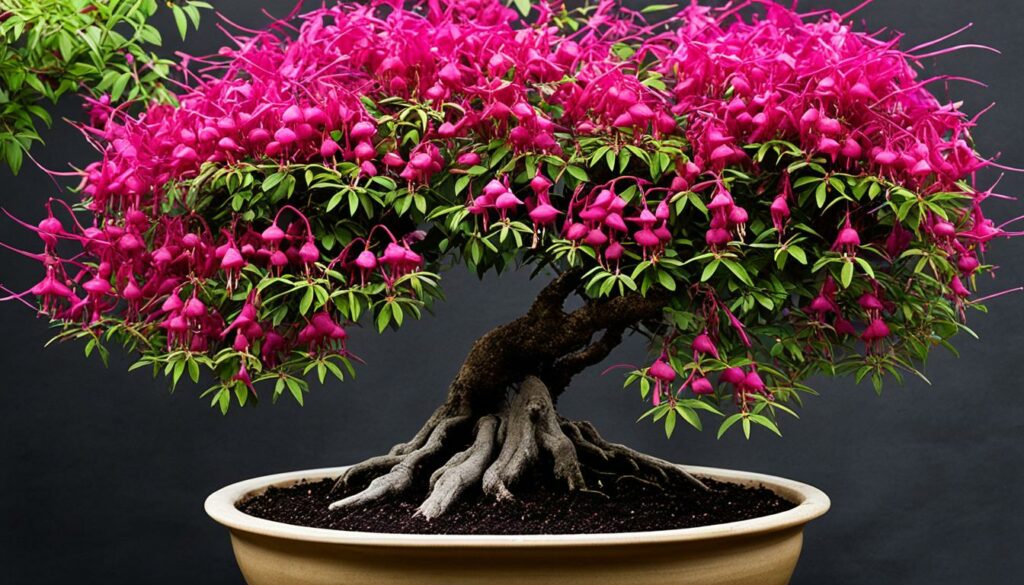
“Remember, bonsai styling is about expressing your artistic vision. Don’t feel limited by these styles, use them as inspiration to create your unique Fuchsia bonsai.”
Seasonal Care Guide for Fuchsia Bonsai
Proper seasonal care is essential for the health and longevity of your Fuchsia bonsai. Each season demands specific attention, and taking care of your bonsai requires a year-round effort. Here’s a seasonal care guide for your Fuchsia bonsai:
Winter
In winter, your Fuchsia bonsai will likely go into dormancy, so it will need less water. Monitor the soil moisture level and only water when the soil is dry about an inch or two below the surface. Protect your bonsai from frost, heavy rain, or snow by moving it indoors or covering it with a protective wrap.
Spring
In spring, your Fuchsia bonsai will start to come out of dormancy and develop new growth. Ensure your bonsai gets sufficient sunlight and water. Begin fertilizing your bonsai with a balanced fertilizer, following the manufacturer’s instructions. It’s recommended to prune your bonsai during spring, trimming back to the shape you desire before new growth appears.
Summer
Summer is the growing season for your Fuchsia bonsai. Ensure it is well-watered and receives adequate sunlight. During the hottest months, consider placing your bonsai in a shaded area to prevent overheating. Continue fertilizing your bonsai every other week with a high-nitrogen fertilizer to promote foliage growth.
Fall
In fall, your Fuchsia bonsai will begin to slow its growth as it prepares for dormancy. Continue to monitor the soil moisture level and reduce watering, but don’t let the soil dry out completely. Reduce fertilizing to once a month and switch to a lower-nitrogen fertilizer to help the bonsai prepare for winter. Do not prune your bonsai during fall as it may cause new growth, which could be damaged by winter frost.
By following this seasonal care guide, you can ensure your Fuchsia bonsai stays healthy and vibrant year-round.
Showcasing the Fuchsia Bonsai
After putting in all the hard work to care for your Bonsai Tree Species Fuchsia, it’s time to showcase its beauty. One way to display your Fuchsia bonsai is to host it in a prominent spot in your home or garden. Choose an area with good lighting and temperature control to ensure that the bonsai thrives.
You can also create a visually pleasing display by arranging your Fuchsia bonsai with other bonsai trees. This creates a dynamic dynamic combination of texture, color, and style. Consider having your Fuchsia bonsai on a stand or pedestal to give it a more prominent appeal.
When showcasing your Fuchsia bonsai, consider using accent pieces such as rocks, decorative figurines, or a water feature. This creates an inviting and relaxing display that draws the viewer in and encourages them to appreciate the beauty of the bonsai tree.
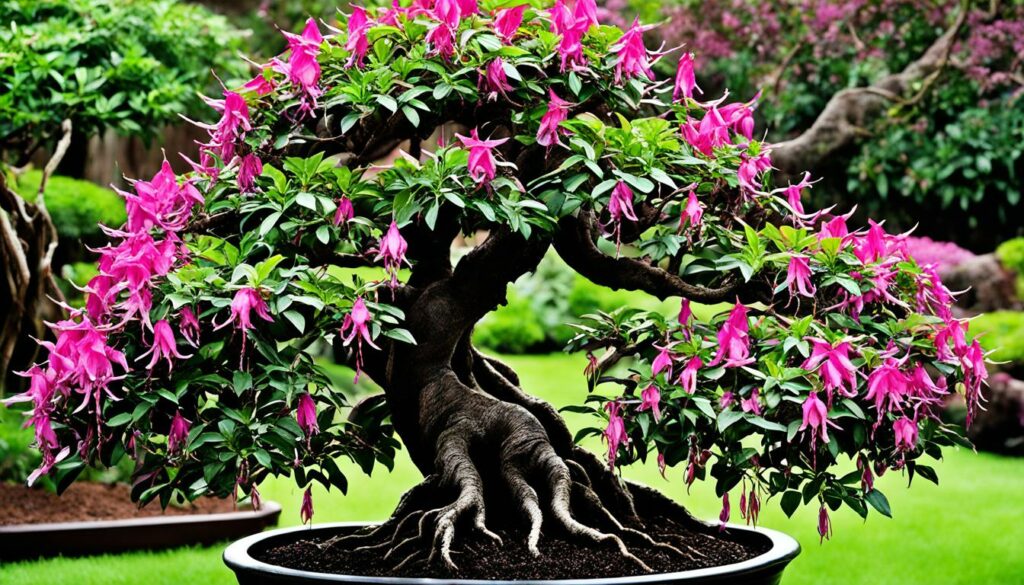
Remember to always keep your Fuchsia bonsai healthy by following the correct care and maintenance procedures outlined in this article. With proper care and a great display, your Fuchsia bonsai can be a true spectacle and a worthwhile experience for you and your guests.
Conclusion
In conclusion, the Bonsai Tree Species Fuchsia is a stunning addition to any bonsai collection. With its vibrant and colorful flowers, small leaves, and distinctive trunk shape, the Fuchsia bonsai offers a unique and captivating display of nature’s beauty.
Proper care and styling are essential for the health and longevity of your Fuchsia bonsai. Remember to water, fertilize, prune, and shape your tree regularly to ensure it thrives. Choose the right pot and soil, and consider different styling options to enhance its natural beauty.
By following our seasonal care guide and protecting your Fuchsia bonsai from pests and diseases, you can enjoy its allure year-round. Display your bonsai in a visually pleasing arrangement to showcase its beauty to full effect.
Embrace the artistry of the Fuchsia bonsai and cultivate your passion for this captivating species. With dedication and patience, you can create a bonsai masterpiece that will bring joy and inspiration for many years to come.
FAQ
What is a Bonsai Tree Species Fuchsia?
A Bonsai Tree Species Fuchsia refers to a specific variety of the popular Fuchsia plant that has been carefully pruned and trained to resemble a miniature tree. This deciduous bonsai is known for its vibrant flowers, small leaves, and distinctive trunk shape.
Why choose a flowering bonsai like the Bonsai Tree Species Fuchsia?
Flowering bonsai trees, such as the Bonsai Tree Species Fuchsia, offer a unique and captivating display of nature’s beauty. The Fuchsia bonsai’s colorful blossoms add a touch of vibrancy and elegance to any bonsai collection.
How do I care for a Fuchsia bonsai?
Proper care is essential for the health and longevity of a Fuchsia bonsai. This section will provide valuable tips on watering, lighting, pruning, and fertilizing to ensure your bonsai thrives.
What pot and soil should I use for my Fuchsia bonsai?
Selecting the appropriate pot and soil is crucial for the well-being of your Fuchsia bonsai. We will discuss the ideal pot size, material, and suitable soil composition for optimal growth.
How do I prune and shape my Fuchsia bonsai?
Pruning and shaping are key techniques in maintaining the desired form and aesthetics of a Fuchsia bonsai. Learn how to properly prune and shape your tree to enhance its natural beauty.
When and how should I repot my Fuchsia bonsai?
Repotting and transplanting are necessary steps in the bonsai’s growth cycle. Discover when and how to repot your Fuchsia bonsai to ensure its roots have adequate space and nutrients.
How can I protect my Fuchsia bonsai from pests and diseases?
Pests and diseases can compromise the health of your Fuchsia bonsai. Learn about common pests and diseases that affect bonsai trees and how to prevent and treat them effectively.
What styling options are available for the Fuchsia bonsai?
The Fuchsia bonsai offers various styling options, including informal upright, cascade, and broom styles. Explore different styling techniques and choose the one that best suits your artistic vision.
How do I care for my Fuchsia bonsai throughout the seasons?
Each season requires specific care for your Fuchsia bonsai. From winter dormancy to spring blooming, follow our seasonal care guide to ensure your bonsai thrives year-round.
How can I showcase the beauty of my Fuchsia bonsai?
Displaying your Fuchsia bonsai in the most favorable way can truly showcase its beauty. Learn about suitable display techniques and how to create a visually pleasing arrangement for your bonsai.
What makes the Bonsai Tree Species Fuchsia a captivating choice for bonsai enthusiasts?
The Bonsai Tree Species Fuchsia adds a vibrant and colorful touch to any bonsai collection. Its stunning flowers, combined with proper care and styling, make it a perfect choice for bonsai enthusiasts looking for elegance and allure.
